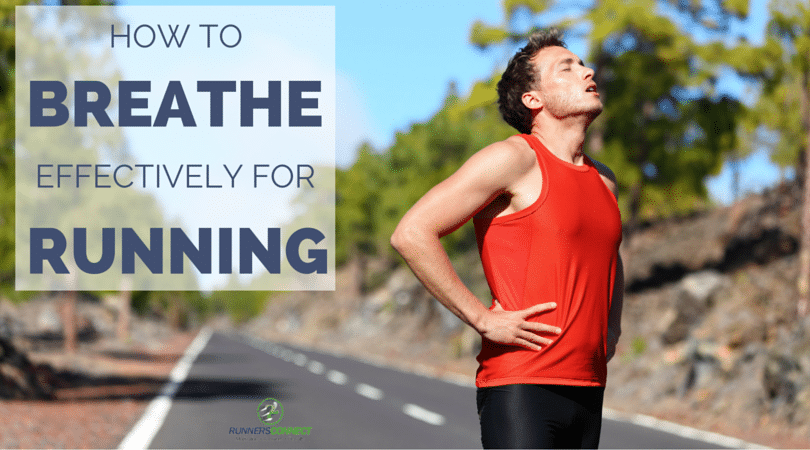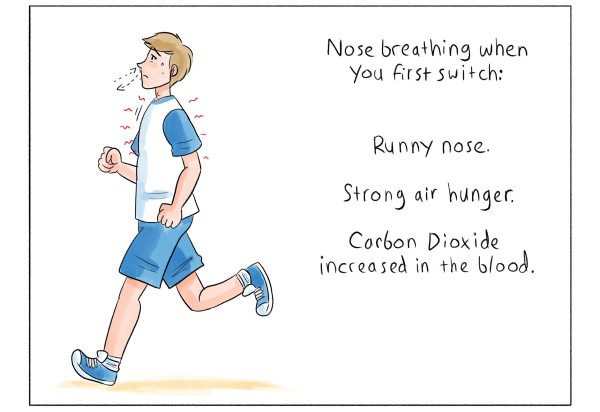How to Breathe When Running?
To breathe when running, focus on taking deep, rhythmic breaths. Inhale through your nose and exhale fully through your mouth.
Proper breathing can improve your running performance and prevent discomfort or injury. Running is a great form of exercise that can improve cardiovascular health, boost mood, and aid in weight loss. However, many new runners may find themselves struggling with proper breathing techniques.
Focusing on taking deep, rhythmic breaths can help prevent discomfort and injury while improving overall performance. Inhaling through the nose and exhaling fully through the mouth can help ensure adequate oxygen intake while expelling carbon dioxide. It’s also important to maintain a relaxed posture, avoid shallow breathing, and gradually increase intensity and distance. With proper breathing techniques, running can become an enjoyable and rewarding activity.

Credit: www.runandbecome.com
Establishing The Right Breathing Rhythm
Establishing the right breathing rhythm is crucial for runners, especially beginners, to perform better. When it comes to running, the right breathing technique is just as important as the right stride. NASAL BREATHING VS MOUTH BREATHING, COUNTING YOUR BREATH, and COORDINATION WITH STRIDE are three ways runners can establish the right breathing rhythm.
Nasal Breathing Vs Mouth Breathing
Nasal breathing involves inhaling and exhaling only through the nose while mouth breathing involves inhaling and exhaling only through the mouth. When running, nasal breathing may be beneficial for some runners. It helps filter out impurities in the air and can reduce the likelihood of breathing in too much dry and cold air, which may irritate the lungs. However, during high-intensity running, mouth breathing may be a better option.
Counting Your Breath
Another way runners can establish the right breathing rhythm is by counting their breath. This involves breathing in for a certain number of steps and then breathing out for another number of steps. It can be helpful for runners to count their breath to create a regular breathing pattern that is synchronized with their movements, making their run smoother and more efficient. For instance, some runners may find that breathing in for three steps and breathing out for two steps works for them.
Coordination With Stride
The coordination of breathing rhythm with your strides is also an important factor in establishing the right breathing rhythm. This involves breathing in when one foot hits the ground and breathing out when the other foot hits the ground. This coordination can be helpful in reducing the impact on the body and improving balance.
In summary, by considering NASAL BREATHING VS MOUTH BREATHING, COUNTING YOUR BREATH, and COORDINATION WITH STRIDE, runners can establish the right breathing rhythm to make their runs more efficient and enjoyable.

Credit: runnersconnect.net
Correcting Common Breathing Mistakes
Correcting common breathing mistakes while running can significantly improve your performance and prevent injuries. One of the most important aspects of breathing while running is to inhale through your nose and exhale through your mouth, maintaining a consistent rhythm to ensure proper oxygenation.
When it comes to running, breathing can be one of the biggest challenges that runners face. It’s important not only for maintaining performance but also for minimizing the risk of injuries. Proper breathing can help you achieve optimal performance and avoid injuries. Correcting common breathing mistakes is critical to improving your breathing. Here are a few common breathing mistakes and how to correct them.Shallow Breathing
Shallow breathing is common among many runners. It is when a runner takes small, shallow breaths, which can lead to fatigue and exhaustion. Shallow breathing also limits the amount of oxygen that gets to the muscles, which can lead to muscle cramps. To correct shallow breathing, take deep breaths from your diaphragm instead of chest breathing. Place your hand on your stomach and feel it expand as you inhale and then contract as you exhale. This will help you take in more oxygen and release carbon dioxide more effectively.Holding Your Breath
Holding your breath while running can lead to increased tension and fatigue. You may find yourself running out of breath more quickly, which can slow you down and reduce your performance. To correct this mistake, try coordinating your breathing with your steps. Inhale for three steps and exhale for two. You can also try breathing in rhythm with your arm swings.Panting Vs Steady Breathing
Panting, or rapid shallow breathing, can be harmful to your body. It can cause lightheadedness, dizziness and decreased performance. On the other hand, steady breathing can help you increase endurance and control your heart rate. To correct panting, try slowing down your pace and breathing deeply. This will help you take in more oxygen and release carbon dioxide more effectively. You can also try to maintain a steady rhythmic breathing pattern to help you improve your endurance. In conclusion, correcting common breathing mistakes can significantly improve your running experience. By following the tips and techniques mentioned above, you can improve your breathing, increase endurance, and reduce the risk of injuries. Remember, proper breathing is essential for improving your performance and staying healthy.Using Supplements And Aids For Better Breathing
Looking for ways to improve your breathing while running? Supplements and aids can help increase lung capacity, reduce inflammation, and improve oxygen flow. A proper breathing technique and using these aids can help you run longer and stronger.
Using Supplements and Aids for Better Breathing: Running is a strenuous physical activity that requires your body to work harder, leading to faster breathing and higher heart rate. It’s essential to breathe in a controlled and efficient manner to prevent exhaustion and maximize performance. While breathing correctly is a crucial element of running, using supplements and aids can also improve your breathing. In this section, we’ll discuss the three most common aids for better breathing – essential oils, breathing devices, and breathing techniques. Essential Oils: Using essential oils to improve breathing while running is a growing trend among runners. Essential oils are highly concentrated plant extracts that help support various bodily functions. Peppermint oil is one of the most popular essential oils for running. Its natural menthol content has a cooling effect on the airways and helps expand the bronchial passages, leading to better airflow and easier breathing. Another useful essential oil is eucalyptus oil, renowned for its respiratory-boosting properties. Adding a few drops of essential oils to a carrier oil and inhaling it before or after running can be beneficial for respiratory support. Breathing Devices: Breathing devices are becoming increasingly popular with runners, helping to maximize their breathing potential. A respiratory muscle trainer (RMT) is an example of a breathing device, consisting of a small handheld instrument that exercises the respiratory muscles to enhance breathing efficiency. The device works by generating resistance when inhaling and exhaling, forcing the respiratory muscles to work harder, leading to improved breathing performance when running. Breathing Techniques: Breathing techniques are an excellent way to improve breathing efficacy, relax and decrease stress while running. One of the most effective breathing techniques for runners is known as the 2:2-technique. This technique involves inhaling for two steps (left, right), followed by exhaling for two steps (left, right). The rhythmic pattern helps runners coordinate their breath with their cadence and maintain a steady flow of oxygen throughout their body. In conclusion, using supplements and aids for better breathing can significantly improve your running game. Essential oils can help boost the bronchial passages’ dilation, while breathing devices and techniques can exercise respiratory muscles and promote respiratory efficiency. Incorporating these aids into your running routine can enhance your body’s oxygen intake and delivery, enabling you to run more efficiently and for more extended periods.Incorporating Breathing Exercises Into Your Routine
Improve your running performance by incorporating breathing exercises into your routine. Learn how to regulate your breath while running to help increase endurance and improve overall performance.
Running involves more than just moving your legs and arms, it also requires proper breathing techniques. While running, the body requires a tremendous amount of energy and oxygen, which is supplied through proper breathing. Incorporating different breathing exercises into your running routine can help improve your endurance, prevent fatigue, and enhance your running performance. Here are three breathing exercises that can help you maintain proper breathing while running.Diaphragmatic Breathing
Diaphragmatic breathing, also known as belly breathing or deep breathing, is an effective way to improve your lung capacity and increase oxygen flow to the muscles. To perform this exercise, stand or sit up straight, and place your hand on your stomach. Breathe in slowly through your nose, and feel your stomach inflate with air. Hold the breath for a few seconds and then exhale through your mouth, allowing your stomach to deflate. Repeat this exercise for five minutes, gradually increasing the time as you get better at it.Pursed Lip Breathing
Pursed lip breathing helps to regulate your breathing and prevent shortness of breath, making it perfect for runners who suffer from asthma or other breathing difficulties. For this exercise, inhale slowly through your nose and exhale through your mouth like you are blowing a candle. Press your lips together like you are about to whistle and exhale slowly. Repeat the exercise for five to ten minutes, gradually increasing the duration as you become better.Alternate Nostril Breathing
Alternate nostril breathing is a yogic technique that can help calm and relax your mind while stabilizing your breathing pattern. Sit comfortably with your spine and head erect, and close your right nostril with your thumb while breathing in through your left nostril. Pause for a second and then close your left nostril with your ring finger, while releasing your right nostril and exhaling through it. Repeat the process by inhaling through the right nostril and exhaling through the left nostril. Repeat the entire process for five minutes. Incorporate these breathing exercises into your running routine and experience the benefits of better oxygen supply, increased endurance, and enhanced running performance. With time, these exercises will become second nature, and your breathing will become more natural and automatic while running.
Credit: www.runandbecome.com
Frequently Asked Questions Of How To Breathe When Running?
How Do You Control Breathing When Running?
To control your breathing while running, focus on taking slow and deep breaths through your nose and exhaling through your mouth. Breathe in rhythm with your steps and try to maintain a consistent pace. Additionally, practicing diaphragmatic breathing and incorporating breathing exercises into your training routine can also improve your breathing control while running.
Why Do I Struggle To Breathe When Running?
Struggling to breathe when running is a common issue for many people. It happens because your body requires more oxygen during exercise and your breaths may become shallow. Making sure to breathe deeply from your diaphragm, pacing yourself, and strengthening your cardiovascular system through regular exercise can help alleviate this problem.
Should I Breathe Through My Nose Or Mouth When Running?
It’s recommended to breathe through your nose when running as it helps to warm, filter, and humidify the air. Nose breathing can also improve endurance by optimizing the body’s oxygen usage. However, if you cannot get enough air through your nose, breathing through your mouth is acceptable.
Just make sure to breathe steadily and rhythmically.
Conclusion
Adopting a proper breathing technique can significantly improve your running performance and prevent potential injuries. Remember to breathe deeply using your diaphragm and synchronize it with your strides. Practice belly breathing and exhale vigorously to get rid of any CO2 buildup in your lungs.
Avoid shallow breathing and maintain a consistent rhythm throughout your run. With practice, you’ll develop a natural breathing pattern and enjoy a more efficient and enjoyable running experience. Happy trails!





